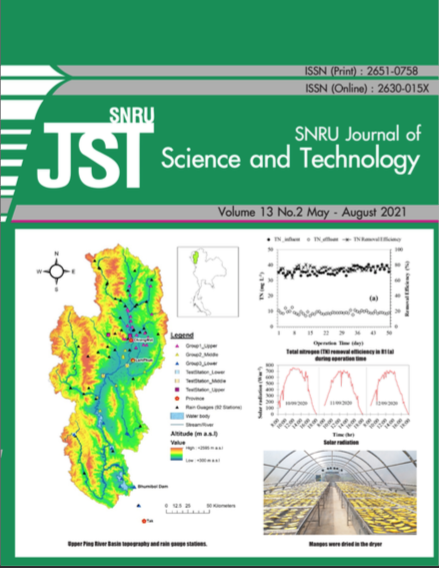Evaluating Inverse Distance Weighting and Correlation Coefficient Weighting Infilling Methods on Daily Rainfall Time Series
Keywords:
infilling method, daily rainfall, missing data, inverse distance weighting method, correlation weighting methodAbstract
Encountering missing daily rainfall records is inevitable and filling the gap is a challenging issue. Spatial interpolation is one of the most widely used methods to estimate missing daily rainfall. The method is easy to apply, less time consuming, and requires inexpensive computation than more complex methods. This study attempted to evaluate the inverse distance weighting (IDW) and correlation coefficient weighting (CCW) methods and compare each method’s performance over the Upper Ping River Basin. Daily rainfall data from 92 stations over about 65 years (1953 – 2017) were obtained. After screening, 44 stations were used in this study. Before implementing infilling methods, cluster analysis using K-means was applied to group the station into three sub-regions. Three and four neighbor stations (source stations, SSs) were tested to find the optimal number of SSs. Six target stations from three sub-areas were chosen to test the infilling method with different percentages of missing values to represent various numbers of missing data. The study results revealed that CCW provided better performance than the IDW method. The optimal number of source stations to estimate missing data was four stations assessed by evaluating mean values, R correlation and similarity index. Moreover, CCW also yielded less error of mean absolute error (MAE) and root means square error (RMSE) compared to IDW. Varying the percentage missing values between 5%, 10%, 20%, 30%, 40%, and 50% revealed that each infilling method was not sensitive to the percentage of missing data.
References
[2] J. Kim, J.H. Ryu, A heuristic gap filling method for daily precipitation series, Water Resour Manag. 30 (2016) 2275 – 2294.
[3] L.R. Presti, E. Barca, G. Passarella, A methodology for treating missing data applied to daily rainfall data in the Candelaro River Basin (Italy), Environ Monit Assess. 160 (2010) 1 – 22.
[4] D. Mora, G. Wyseure, P. Willems, Gap filling based on a quantile perturbation factor technique, 11th
International Conference on Hydroinformatics, New York City. August 2014, 1 – 8.
[5] C. Simolo, M. Brunetti, M. Maugeri, T. Nanni, Improving estimation of missing values in daily precipitation series by a probability density function-preserving approach, Int J Climatol. 30 (2010), 1564 – 1576.
[6] M. M. Hasan, B. F. W. Crokea, Filling gaps in daily rainfall data: a statistical approach, 20th International Congress on Modelling and Simulation, Adelaide, Australia, December 2013, 380 – 386.
[7] H. Aksoy, Use of gamma distribution in hydrological analysis, Turk J Engin Environ Sci. 24 (2000), 419 – 428.
[8] M. A. Malek, S. Harun, S. M. Shamsuddin, I. Mohamad, Reconstruction of missing daily rainfall data using unsupervised Artificial Neural Network, World Acad Sci Eng Technol. 44 (2008), 616 – 621.
[9] D.B. Rubin, Inference and missing data, Biometrika. 63 (1976), 581 – 592.
[10] R.J.A. Little, D.B. Rubin, Statistical analysis with missing data, Wiley, New York 1987.
[11] Y. Xia, P. Fabian, A. Stohl, M. Winterhalter, Forest climatology: estimation of missing values for Bavaria, Germany, Agric For Meteorol. 96 (1999), 131 – 144.
[12] R. Teegavarapu, V. Chandramouli, Improved weighting methods, deterministic and stochastic data-driven, models for estimation of missing precipitation records, J. Hydrol. 312 (2005), 191 – 206.
[13] A. Barrios, G. Trincado, R. Garreaud, Alternative approaches for estimating missing climate data: application to monthly precipitation records in South-Central Chile, For. Ecosyst. 5 (2018).
[14] Y. Tan, J.L. Ng, Y. Huang, Estimation of missing of missing dailry rainfall during monsoon seasons for tropical region: A comparison between ANN and conventional methods, Carpathian J. Earth Environ. Sci. 15 (2020), 103 – 112.
[15] N. Aishah Rahman, S. Mohd Deni, N. Mohamed Ramli, N. Shaadan, The improvement of missing rainfall data estimation during rainy season at Ampang station, Int. J. Eng. Technol. 7 (2018), 204 – 212.
[16] J. El Kasri, A. Lahmili, O. Latifa, L. Bahi, S. Halima, M.A. Mitach, Comparison of the relevance and performance of filling in gaps methods in rainfall datasets, Int. J. Civ. Eng. Technol. 9 (2018), 992– 1000.
[17] R. Teegavarapu, Estimation of missing precipitation records integrating surface interpolation techniques and spatio-temporal association rules, J. Hydroinformatics. 11 (2019), 133 – 146.








